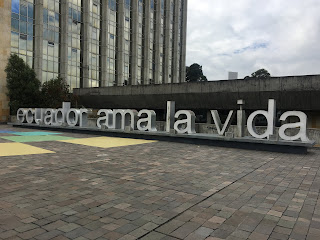QUITO, ECUADOR, A TIRED WORLD HERITAGE CITY
Quito in Ecuador holds a world heritage city status since 1978 and it is the oldest capital in South America. It has been exactly a long 40 years in 2018. In Centro Cultural Metropolitano the municipality holds an exhibition about QUITO 2040, a vision for the city in the future. It adopted Sustainable Development Goals one to eleven. It is generic but it gives direction and explanation to the locals where the city goes. The city does its best to maintain quality of life and its historic city centre but age doesn't lie. Run down and empty buildings look depressing. Traffic congestion pressures pedestrians. Waste management is rather poor. Public bikes are broken. Quito needs drastic policies to regain its glorious past.
The Getty Conservation Institute has assisted Quito between 1991-1997. Work
included a photogrammetric study of historic buildings; investigation of the color history of
building facades; environmental monitoring; conservation advice; and an international colloquium on the seismic
retrofitting of historic buildings.
The reports about those efforts are very true and interesting to squeeze the lessons learned for other cities all over the world. I do hope that Indonesian cities that dream to nominate themselves as world heritage cities will learn first from Quito's experiences.
I personally agree with those reports and analysis after walking through streets and alleys of the historic city center of Quito. It is hard to keep quality of environment in a long period if a city doesn't try hard to maintain every details of its infrastructure and doesn't assertive to enforce necessary laws and regulations.
Despite challenges being a world heritage city, outside the historic city centre, Quito offers reasonable quality of life to its residents. A Sunday in the Carolina Park (Parque La Carolina), for example, is a place to be for all ages. The park has something for everyone: spaces for different kind of exercises, recreations, entertainments, religious speeches, food stalls or simply for doing nothing. It is very obvious what positive energy a park has for a busy city like Quito.
















Comments